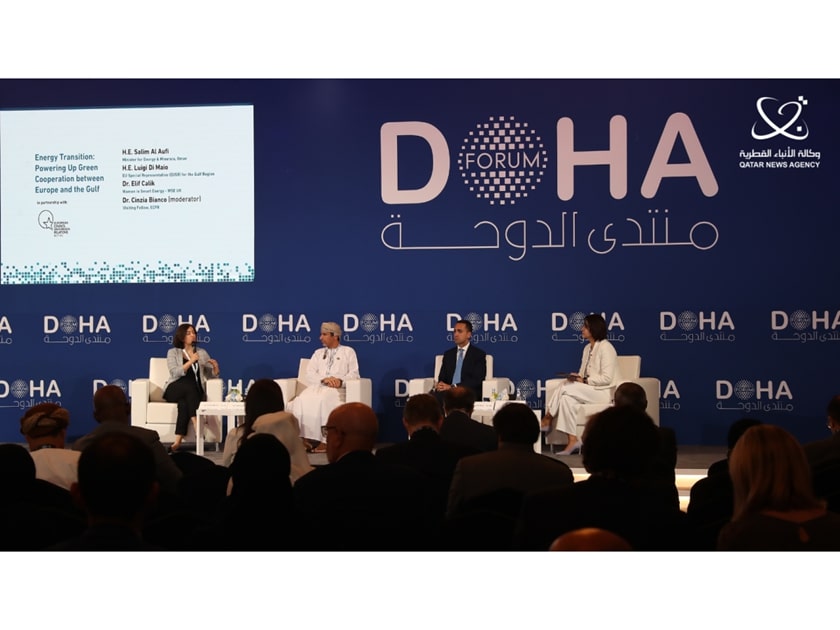Doha, Qatar— Oil and gas producers in the Middle East are assessing “challenges and opportunities” available for their economies to grow while depending on hydrocarbon by working to enhance cooperation in the rapid transitions in the European energy field.
The eagerness to make a transition toward clean energy and strike an alliance with Europe was evident during a discussion at the Doha Forum 2023 on Sunday. The talk covered opportunities for green cooperation between the Gulf and Europe, the importance of strengthening this cooperation, and the ways that can form the framework for cooperation on energy and climate issues between the two sides.
The session “Energy Transition: Powering Up Green Cooperation between Europe and the Gulf”, which was held as part of the forum’s agenda, underlined many of the opportunities that this transformation provides for both regions, such as diversifying their economies and stimulating development cooperation and economic investments.
The session also reviewed the challenges that this transformation brings in terms of differing opinions and the importance of creating common standards, especially regarding how fast this transition must be. Other challenges included infrastructure, exports and technology, including reliance on certain types of technology for renewable energy sources, the necessary raw materials in the transition phase, supply chains and more.
The session also touched on the internal challenges of each specific region, including green jobs and the importance of training a new workforce, creating a single market in the European Union, and including a comprehensive approach towards other countries in the MENA region to have them as a stop during the export process and be part of this infrastructure.
Minister of Energy and Minerals of Oman Eng. Salim Nasser Al Aufi noted the increasing and important role in the field of green energy that his country is playing. Oman had announced that it is in a position where it can become a global center when it comes to hydrogen, specifically green hydrogen, which would overall be used internationally in one form or another.
Eng. Al Aufi also explained Oman’s great potential in regard to solar or wind energy, the size of the areas provided for green hydrogen in the country, the signed projects, the means of entering into those projects, as well as the related numbers and indicators.
Oman’s Minister of Energy and Minerals also reviewed his country’s efforts in transitioning to renewable energy and finding more efficient ways to transport hydrogen, including the country’s plans to establish a joint infrastructure for exporting green hydrogen, especially after signing a Joint Study Agreement (JSA) with the Port of Amsterdam, Zenith Energy Terminals and GasLog to cooperate on developing liquid hydrogen route for the green hydrogen market produced in Oman.
He explained that the JSA allows the establishment of the world’s first commercial-scale liquid hydrogen route. It focuses on studying opportunities to develop the Omani green hydrogen supply chain and export it to the Port of Amsterdam and from there to Europe.
This is with the aim of finding other and more efficient ways to transport hydrogen other than the currently used methods of converting hydrogen energy into ammonia or methanol.
Minister of Energy and Minerals of Oman Eng. Salim Nasser Al Aufi underlined that the area of renewable energy lands in Oman amounts to about 50,000 square kilometers, which will be exploited in various stages.
Oman has set its goal of producing at least one million tons annually by the year 2030 and reaching the exploitation of 30 percent of the lands currently allocated to the production of approximately 8 million tons of hydrogen in 2050. He also noted in this regard the cooperation with some European countries such as Belgium, the Netherlands and Germany.
European Union (EU) Special Representative (EUSR) for the Gulf Region Luigi Di Maio said that the appointment of an accredited representative for the Gulf region, especially for relations with the Gulf Cooperation Council (GCC) countries, is part of a more comprehensive EU strategy for the region.
He explained that they have begun a new strategy to bring more attention to the Gulf and the strategic partnership, one that goes beyond the old ways of energy supply to new energies, as the countries of both regions invest heavily in diversifying their economies as well as in renewable energy sources.
The EUSR for the Gulf Region explained that his role includes five main pillars: trade, energy (with a particular focus on renewable energy sources), regional security, relations between societies, and relations between institutions.
He noted the agreement reached during the joint council between the GCC countries and the EU last October in Oman.
The agreement states the continuous participation in a common goal to remove carbon from energy systems and the joint green transformation in the countries’ economies by strengthening technical cooperation, including hydrogen, energy efficiency, integration of renewable energy sources and development of electrical interconnection, with the ultimate goal of achieving climate neutrality.
Although there are different opinions about how fast the energy transition should be, Di Maio said that everyone realizes today that the energy transition requires some time to achieve some results. The common goals lie in the Paris Agreement on climate, as it pushes everyone in unison to achieve the desired goals.
The “Energy Transition: Powering Up Green Cooperation between Europe and the Gulf” session focused on whether this new framework could serve as a blueprint for importers and exporters around the world to work together to promote a smooth energy transition.

